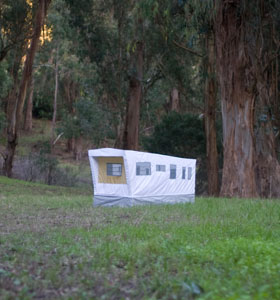


My work is not necessarily art. I make work that is rooted in personal experiences, both in current experiences and from childhood. I find concepts that are relevant for periods in my life and I find objects/subjects that stand as symbols for these experiences. I find that utilizing things already in existence allows others to more readily draw upon their own experiences to relate.
Gregory Crewdson, Diane Arbus, Andrea Zittel, the belchers, Seiko Tachibana, Anthony May
Not fucking it up. My main challenge is structural and technical. It is hard to get a rectangular tent to stand on its own and to be functional. Also, fabric is expensive and if I mess up in the sewing I don’t have much room to fix mistakes. This is also part of the fun.
In the middle of the night when I'm trying to go to sleep. An idea will pop into my head and I cant sleep until I work through it from beginning to end. Those make for late nights.
When I am on a deadline or when I am supposed to be doing something else.
It would be a great honor, not only for the recognition of my peers but also for the prestige amongst this group.

MOVE*ment
The Concept of the MOVE*ment Project
MOVE*ment is a project that examines the schizophrenic limitations and freedoms experienced during times of transition. This project is rooted in moving which is something I have experienced multiple times throughout my childhood. Subconsciously emerging just before my most recent move from North Carolina to California, I began photographing these mobile homes in a documentary style simply to capture their aesthetics in relation to the landscapes. The project has since evolved into an edition of ten artist books, a tri-series of tent structures and subsequently new series of photographs taken in landscapes of locations I have lived. In relation to the current economic slump, I began to see these dwellings as a reflection of a new cultural movement towards a rational structure that satisfies basic living needs while weathering the country’s financial instabilities.
The Concept of the Tent
These tents are fully functional, weather resistant, temporal nomadic structures that carry notions of nostalgic Americana trends and conceivably reference a mass-produced commodity. The variable locations of these tents shift the context of their inherent reference. If placed in a remote part of a hiking trip the sense of the get away ensues and the mobility and temporality will be heightened. If placed in a state park campground with the modern accessories of a paved driveway matted down tent area, fire pit and water spicketts, the context will shift to more communal aspects of the trailer park. Furthermore, the idea that one will camp in the same site for a more extended period of time will reiterate the concept of extended temporality. If this tent is viewed in a white walled gallery, it will be seen as a work of art. The tents are the catalyst for conversation when placed various contexts that create the frameworks of their function.

When asked, "Where are you from?" Lacey will shrug her shoulders and ask for clarification of the statement. Lacey was born in Reno, NV and spent most of her childhood moving with her family through the southern United States. Starting in Nevada, then heading to Texas and finally spending most of her younger years in the piedmont region of North Carolina, Lacey has had to adapt to life's transitional stages. While attending boarding school in upstate New York, Lacey began to photograph to de-stress from the rigors of academia. After her first year of college, attending The University of North Carolina at Asheville located in the Blue Ridge Mountains of NC, she realized the art field was where she belonged. A year after graduating from UNC-A in 2006, Lacey packed up her car and crossed the country again, this time to California in order to teach photography. While settling back into west coast life, she was accepted to the MFA program at San Francisco Art Institute where she currently attends until May, 2011. Lacey’s travels heavily influence her work. She uses the medium of photography to document the conceptual essence of evolving places in relation to the passing of time.